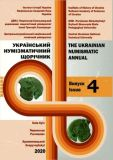МОНЕТНО-РЕЧОВИЙ СКАРБ ПЕРШОЇ ПОЛОВИНИ ІХ СТОЛІТТЯ З ЧЕРКАСЬКОЇ ОБЛАСТІ
FIRST HALF OF THE IXTH CENTURY COIN-WARE HOARD FROM CHERKASY REGION
Author(s): Yevhen Lemberg, Anatoly ShostopalSubject(s): Archaeology, Economic history, 6th to 12th Centuries
Published by: ДВНЗ Переяслав-Хмельницький державний педагогічний університет імені Григорія Сковороди
Keywords: Abbasids; treasure; Cherkasy region; kufic dirhams; Khazar kaganate; Luke-Raykovetsk culture;
Summary/Abstract: The article describes a numismatic part of the coin-ware hoard, which was found near khutor Kobelyaky, Zvenigorodski raion, Cherkasy oblast’ in May 2017. The hoard was confined within a small grey-brown clay elongated pot. The top part of the pot is missing. Its height is reconstructed as about 17 cm, maximum diameter – 12,5 cm, the width of the walls – about 0,8 cm. The pot was made from the clay with the inclusion of coarse grog. As it was reported by the finders, the pot contained 74 Kufic dirhams of, presumably, Abbasid mintage and two silver cervical grivna, made from tetrahedral silver wire (2*2 mm in section). One of the grivnas was broken into two parts. There were also three silver bracelets and about ten double-pointed beads, made either from a silver-plated tin of tin-copper alloy. Unfortunately, grivnas, bracelets, and beads had been sold by finders before this hoard was available to the authors and they were known only by photos, taken by the finders. From 74 Kufic dirhams, reported by the finders, only the group of 64 coins was provided for the current research. Of these coins, 59 were struck by Abbasids, 1 – by Idrisids, 4 – by Kharijites of North Africa. The earliest dirham within the group was minted in Kufa in 139 AH (756/757 CE). The latest – in Madinat Isbahan in 205 AH (820/821 CE). The article evaluates possible causes and ways for the hoard appearance at the territory of the Cherkasy region. The attributed dirhams originate from seven regions of the Islamic world: 1) Maghreb (Abbasiya, Ifriqiya, Tudgha) – 32 pieces; 2) Iraq (Basra, Kufa, Madinat al-Salam) – 14 pieces; 3) Jibal (Muhammadiya, Madinat Isbahan) – 8 pieces; 4) Caucasus (Arminiya, Ma’dan Bajunays, Muhammadiya II) – 5 pieces; 5) Khorasan (Madinat Herat, Madinat Naysabur) – 2 pieces; 6) Mawarannahr (Ma’dan Shash) – 2 pieces; 7) Kirman (Kirman) – 1 piece. Composition of the Hoard confirms a statement of Roman Kovalev that “before 825 CE, North African dirhams, struck at such mints as Abbasiya and Ifriqiya, compose about 50% of all dirhams, hoarded in Eastern Europe”. A coin #22, attributed as Kirman, 168 AH, temp. of caliph al-Hadi, is interesting as it is actually a so-called “mule”, i.e. coin struck by the noncontemporaneous obverse and reverse stamps. The legend of the obverse shows year 168 AH, when caliph al-Mahdi was still in power, while the legend of reverse clearly states Musa, a personal name of caliph al-Hadi, who came to power only in 169 AH. It is also worthy of attention that just three coins (##9, 51,52) from the whole hoard, are pierced for hanging, i.e. might have been used as decoration. The Terminus Post Quem of the hoard, taking into consideration some time for the arrival of the coins to the area around the middle part of the Dnepr river, is established as the first half-middle of the IXth century. This period corresponds to the time of Luka-Rajki culture existence at Right Bank of Dnepr river. Researchers believe that particular Ulichs, one of the “chronicle’s tribes” that remarked in “Tale of Bygone Years”, have left us archaeological artifacts of Luka-Rajki type. This hoard is unique for Cherkasy oblast’ by composition as well as by the quantity of the discovered Kufic coins. For the period of Slavic tribes strengthening and Kyivan Rus formation, there are more finds of the Byzantine coins at the territory of the oblast’, while Kufic coins are much rarer. The Discovery of this coin-ware hoard may point to the routes of a distribution and a circulation of the Kufic coins. The dates of the dirhams from the hoard attest that they had arrived in the area around the middle part of the Dnepr river during the first half-middle of the IXth century yet before a formation of Old Russian state with the center in Kyiv. The trade routes of the VIII-IX century are much better defined for the Left Bank of Dnepr River. This hoard, together with other discoveries of Kufic coins either in Cherkasy region or in more western oblast’ of Ukraine may help to determinate such trade routes for the Right Bank of Dnepr River and Western Ukraine.
Journal: Український Нумізматичний Щорічник
- Issue Year: 2020
- Issue No: 4
- Page Range: 58-69
- Page Count: 12
- Language: Ukrainian

